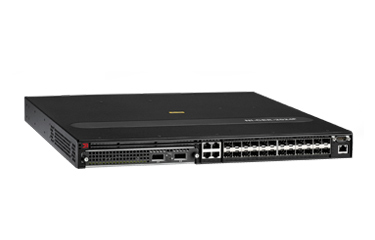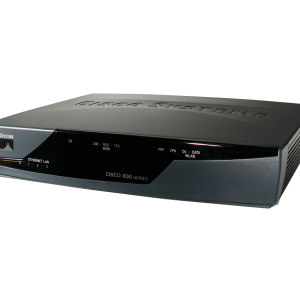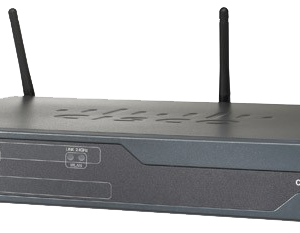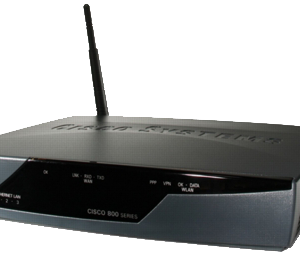Brocade NetIron CER 2000 Series PN NI-CER-2024C-ADVPREM-AC
Call for pricing
Brocade NetIron CER 2000 Series (PN: NI-CER-2024C-ADVPREM-AC)
Brocade NetIron CER 2000 Series compact routers are purpose-built for high-performance Ethernet edge routing, MPLS, and SDN. These 10 GbE-enabled fixed-form routers can store a complete Internet table and are ideal for supporting routing applications cost-effectively in Metro Ethernet, data center, and campus networks.
In addition to providing unmatched route scalability in a flexible form, the NetIron CER 2000 supports OpenFlow, providing an SDN solution for programmatic control of the network.
Product Description
Brocade NetIron CER 2000 Series
Part Number: NI-CER-2024C-ADVPREM-AC
Brocade NetIron CER 2000 Series routers are purpose-built to help save on space, power, and cooling expenses while extending wire-speed IP and Multi-Protocol Label Switching (MPLS) services to the network edge without compromising performance.
The NetIron CER 2000 is available in 24- and 48-port 1 Gigabit Ethernet (GbE) copper and hybrid fiber configurations with four or two 10 GbE ports. To ensure high performance, all the ports are capable of forwarding IP and MPLS packets at wire speed without oversubscription. With less than 5 watts/Gbps of power consumption and up to 136 Gbps of throughput, the NetIron CER 2000 meets the dynamic needs for high-bandwidth services while reducing the carbon footprint.
A broad set of highly scalable IP unicast and multicast routing features, combined with a low total cost of ownership, makes the NetIron CER 2000 an ideal choice for service providers and enterprises that want to deliver Layer 2 and Layer 3 business services through a single, easy-to-manage platform.
Software-Defined Networking (SDN) is a powerful new network paradigm that provides increased agility and programmatic control of network infrastructure for a new class of IT applications to meet critical business needs.
The NetIron CER 2000 Series enables SDN by supporting the OpenFlow protocol, which allows communication between an OpenFlow controller and the OpenFlow-enabled NetIron CER 2000 router.
The NetIron CER 2000 Series delivers OpenFlow 1.3 in hybrid mode, meaning organizations can simultaneously deploy traditional Layer 2 and Layer 3 forwarding with OpenFlow on the same system.
This unique capability enables network operators to integrate OpenFlow into existing networks, providing the benefits offered by SDN for specific flows while the remaining traffic is routed as before.
Important Information
We are not only looking to sell you only one time we look to build long business relation with you.
Warranty & Support
We offer manufacture warranty plus our ICT warranty.
If you need any technical assistant, our expert technicians are always available to help you without any additional cost.
Contact us now and let our team help you.
NetIron CER 2024C includes 24 RJ45 ports of 10/100/1000 Mbps Ethernet with 4 combination RJ45/SFP Gigabit Ethernet for uplink connectivity. Optional slot for 2 ports of 10 Gigabit Ethernet XFP, 500W AC power supply (RPS9), and Advanced Services software
IEEE Compliance
IEEE 802.3 10Base-T
IEEE 802.3u 100Base-TX, 100Base-FX, 100Base-LX
IEEE 802.3z 1000Base-SX/LX
IEEE 802.3ab 1000Base-T
802.3 CSMA/CD AcCERs Method and Physical Layer Specifications
802.3ae 10 Gigabit Ethernet
802.3x Flow Control
802.3ad Link Aggregation
802.1Q Virtual Bridged LANs
802.1D MAC Bridges
802.1w Rapid STP
802.1s Multiple Spanning Trees
802.1x Port-based Network Access Control
802.1ad Provider Bridges
802.1ah Provider Backbone Bridges
802.1ag Connectivity Fault Management (CFM)
ITU Compliance
Y.1731 OAM functions and mechanisms for Ethernet-based networks
ITU-T G.8032 Ethernet Ring Protection (ERP version 1 and 2)
MEF Specifications
MEF 2 Requirements and Framework for Ethernet Service Protection
MEF 4 Metro Ethernet Network Architecture Framework Part 1: Generic Framework
MEF 6.1 Metro Ethernet Services Definitions Phase 2
MEF 9 Abstract Test Suite for Ethernet ServiCER at the UNI
MEF 10.1 Ethernet Services Attributes Phase 2
MEF 11 User Network Interface (UNI) Requirements and Framework
MEF 12 Metro Ethernet Network Architecture Framework Part 2: Ethernet Services Layer
MEF 13 User Network Interface (UNI) Type 1 Implementation Agreement
MEF 14 Abstract Test Suite for Traffic Management Phase 1
MEF 15 Requirements for Management of Metro Ethernet Phase 1 Network Elements
MEF 17 Service OAM Framework and Requirements (partial)
MEF 19 Abstract Test Suite for UNI Type 1
MEF 21 Abstract Test Suite for UNI Type 2 Part 1 Link OAM
RFC Compliance
BGPv4
RFC 4271 BGPv4
RFC 1745 OSPF Interactions
RFC 1997 Communities and Attributes
RFC 2439 Route Flap Dampening
RFC 2796 Route Reflection
RFC 1965 BGP4 Confederations
RFC 2842 Capability Advertisement
RFC 2918 Route Refresh Capability
RFC 1269 Managed Objects for BGP
RFC 2385 BGP Session Protection via TCP MD5
RFC 3682 Generalized TTL Security Mechanism, for eBGP Session Protection
RFC 4273 BGP-4 MIB
RFC 4893 BGP Support for Four-octet AS Number Space
RFC 5396 Textual Representation of Autonomous System (AS) Numbers
RFC 4724 Graceful Restart Mechanism for BGP (helper mode)
OSPF
RFC 2328 OSPF v2
RFC 3101 OSPF NSSA
RFC 1745 OSPF Interactions
RFC 1765 OSPF Database Overflow
RFC 1850 OSPF v2 MIB
RFC 2370 OSPF Opaque LSA Option
RFC 3630 TE Extensions to OSPF v2
RFC 3623 Graceful OSPF Restart (helper mode)
IS-IS
RFC 1195 Routing in TCP/IP and Dual Environments
RFC 1142 OSI IS-IS Intra-domain Routing Protocol
RFC 2763 Dynamic Host Name Exchange
RFC 2966 Domain-wide Prefix Distribution
RFC 5120 IS-IS Multi-Topology Support
RIP
RFC 1058 RIP v1
RFC 2453 RIP v2
RFC 1812 RIP Requirements
IPv4 multicast
RFC 1122 Host Extensions
RFC 1112 IGMP
RFC 2236 IGMP v2
RFC 3376 IGMP v3
RFC 3973 PIM-DM
RFC 2362 PIM-SM
IPv6 core
RFC 2460 IPv6 Specification
RFC 2461 IPv6 Neighbor Discovery
RFC 2462 IPv6 Stateless Address?Auto-Configuration
RFC 4443 ICMPv6
RFC 4291 IPv6 Addressing Architecture
RFC 3587 IPv6 Global Unicast?Address Format
RFC 2375 IPv6 Multicast Address Assignments
RFC 2464 Transmission of IPv6 over Ethernet Networks
RFC 2711 IPv6 Router Alert Option
RFC 3315 Dynamic Host Configuration Protocol (DHCP) for IPv6
IPv6 routing
RFC 2080 RIPng for IPv6
RFC 2740 OSPFv3 for IPv6
draft-ietf-isis-ipv6 Routing IPv6 with IS-IS
RFC 2545 Use of BGP-MP for IPv6
RFC 4659 BGP-MPLS IP Virtual Private Network (VPN) Extension for IPv6
RFC 6106 Support for IPv6 Router Advertisements with DNS Attributes
RFC 6164 Using 127-Bit IPv6 Prefixes on Inter-Router Links
IPv6 transitioning
RFC 4659 Transporting IPv6 Layer 3 VRFs across IPv4/MPLS Backbones (6VPE)
RFC 4798 Connecting IPv6 islands over IPv4 MPLS using IPv6 Provider Edge Routers
MPLS
RFC 3031 MPLS Architecture
RFC 3032 MPLS Label Stack Encoding
RFC 3036 LDP Specification
RFC 2205 RSVP v1 Functional Specification
RFC 2209 RSVP v1 Message Processing Rules
RFC 3209 RSVP-TE
RFC 3270 MPLS Support of Differentiated Services
RFC 3812 MPLS MIB
RFC 4090 Fast Reroute Extensions to RSVP-TE for LSP Tunnels; partial support
RFC 4875 Extensions to RSVP-TE for P2MP TE LSPs
RFC 5443 LDP IGP Synchronization
RFC 5712 MPLS Traffic Engineering Soft Preemption
Layer 2 VPN and PWE3
RFC 4664 Framework for Layer 2 Virtual Private Networks
RFC 4665 Service Requirements for Layer 2 Provider-Provisioned Virtual Private Networks
RFC 4762 VPLS using LDP Signaling
draft-ietf-pwe3-arch PWE3 Architecture
RFC 4447 Pseudowire Setup and Maintenance using LDP
RFC 4448 Encapsulation Methods for Transport of Ethernet over MPLS Networks
RFC 5542 Definitions for Textual Conventions and for Pseudowires (PW) Management
RFC 5601 Pseudowire (PW) Management Information Base
General protocols
RFC 791 IP
RFC 792 ICMP
RFC 793 TCP
RFC 1350 TFTP
RFC 826 ARP
RFC 768 UDP
RFC 894 IP over Ethernet
RFC 903 RARP
RFC 906 TFTP Bootstrap
RFC 1027 Proxy ARP
RFC 951 BootP
RFC 1122 Host Extensions for IP Multicasting
RFC 1256 IRDP
RFC 1519 CIDR
RFC 1542 BootP Extensions
RFC 1812 Requirements for IPv4 Routers
RFC 1541 and 1542 DHCP
RFC 2131 BootP/DHCP Helper
RFC 3768 VRRP
RFC 854 TELNET
RFC 1591 DNS (client)
QoS
RFC 2475 An Architecture for Differentiated Services
RFC 3246 An Expedited Forwarding PHB
RFC 2597 Assured Forwarding PHB Group
RFC 2698 A Two-Rate Three-Color Marker
Other
RFC 1354 IP Forwarding MIB
RFC 2665 Ethernet Interface MIB
RFC 1757 RMON Groups 1, 2, 3, 9
RFC 2068 HTTP
RFC 2030 SNTP
RFC 2865 RADIUS
RFC 3176 sFlow
RFC 2863 Interfaces Group MIB
Draft-ietf-tcpm-tcpsecure TCP Security
draft-ietf-bfd-base Bidirectional Forwarding Detection (BFD)
RFC 4741 NETCONF(Partial)
RFC 4087 IP Tunnel MIB
RFC 4133 Entity MIB
RFC 5676 Definitions of Managed Objects for Mapping SYSLOG Messages to SNMP Notifications
Network Management
Brocade Network Advisor Web-based Graphical User Interface (GUI)
Integrated industry-standard Command Line Interface (CLI)
sFlow (RFC 3176)
Telnet
SNMP v1, v2c, v3
SNMP MIB II
RMON
Support for automated configuration management using NETCONF
Entity MIB (Version 3)
Element Security Options
AAA
RADIUS
Secure Shell (SSH v2)
Secure Copy (SCP v2)
HTTPs
TACACS/TACACS+
Username/Password (Challenge and Response)
Bi-level Access Mode (Standard and EXEC Level)
Protection against Denial of Service attacks, such as TCP SYN or Smurf attacks
Environmental
Temperature
Operating: 0?C to 40?C (32?F to 104?F)
Non-operating: -25?C to 70?C (-13?F to 158?F)
Humidity
Relative: 5% to 90% at 40?C (104?F), non-condensing
Non-operating: 95% maximum relative humidity, non-condensing
Altitude
Operating: 10,000 ft (3048 m)
Non-operating: 15,000 ft (4500 m) maximum
Safety Agency Approvals
CAN/CSA-C22.2 No. 60950-1-3
UL 60950-1
IEC 60950-1
EN 60950-1 Safety of Information Technology Equipment
EN 60825-1 Safety of Laser Products?Part 1: Equipment Classification, Requirements and User’s Guide
EN 60825-2 Safety of Laser Products?Part 2: Safety of Optical Fibre Communication Systems
Electromagnetic Emission
ICES-003 Electromagnetic Emission
FCC Class A
EN 55022/CISPR-22 Class A/VCCI Class A
AS/NZS 55022
EN 61000-3-2 Power Line Harmonics
EN 61000-3-3 Voltage Fluctuation and Flicker
EN 61000-6-3 Emission Standard (Supersedes: EN 50081-1)
Immunity
EN 61000-6-1 Generic Immunity and Susceptibility; this supersedes EN 50082-1
EN 55024 Immunity Characteristics. This supersedes:
EN 61000-4-2 ESD
EN 61000-4-3 Radiated, radio frequency, electromagnetic field
EN 61000-4-4 Electrical fast transient
EN 61000-4-5 Surge
EN 61000-4-6 Conducted disturbances induced by radio-frequency fields
EN 61000-4-8 Power frequency magnetic field
EN 61000-4-11 Voltage dips and sags
Telco NEBS/ETSI
Telcordia GR-63-CORE NEBS Requirements: Physical Protection
Telcordia GR-1089-CORE EMC and Electrical Safety
Telcordia SR-3580 Level 3
ETSI ETS 300-019 Physical Protection:
Part 1-1, Class 1.1, Partly Temperature Controlled Storage Locations
Part 1-2, Class 2.3, Public Transportation
Part 1-3, Class 3.1, Temperature Controlled Locations (Operational)
ETSI ETS 300-386 EMI/EMC
Power and Grounding
ETS 300 132-1 Equipment Requirements for AC Power Equipment Derived from DC Sources
ETS 300 132-2 Equipment Requirements for DC Powered Equipment
ETS 300 253 Facility Requirements
Physical Design and Mounting
Rack mount 19-inch rack mount supporting racks compliant with:
ANSI/EIA-310-D
ETS 300 119
GR-63-CORE Seismic Zone 4
Environmental Regulatory Compliance
EU 2002/95/EC RoHS
EU 2002/96/EC WEEE
Comprehensive IPv4/IPv6 routing support based on the Brocade Multi-Service IronWare OS
High-performance, robust routing using Forwarding Information Base (FIB) programming in hardware
RIP/RIPng, OSPF/OSPFv3, IS-IS/IS-IS for IPv6, and BGP-4/BGP-MP for IPv6
Secure Multi-VRF routing for supporting virtual routing applications over non-MPLS backbones
VRRP and VRRP-E
8-path Equal-Cost Multi-Path (ECMP)
Up to 1.5 million IPv4 unicast routes in FIB
Up to 256,000 IPv6 unicast routes in FIB
Connecting IPv6 islands over IPv4 MPLS using IPv6 Provider Edge (6PE) routers
6VPE enabling IPv6 multitenancy to the edge of the cloud
BFD Holdover for OSPFv2/3 and IS-IS
BDF for Static Routes
BDF for OSPFv3
ND6 IPv6 Prefix Suppress
IS-IS Graceful Restart Helper Mode
127 bit IPv6 interface addresses
Software-Defined Networking (SDN)
OpenFlow 1.3: QoS (for metering and enqueue), Group Table (select and fast failover), QinQ (TAG type auto-recognition), Active-Standby Controller, IPv6, Transport Layer Security (TLS) 1.2 (controller interface)
Brocade OpenFlow hybrid switch mode for OpenFlow capabilities on the same system as traditional routing or switching features
Support for up to 32,000 OpenFlow flows
Rich multicast support
IPv4 multicast protocols, including PIM-DM, PIM-SM, and PIM-SSM
IPv6 multicast support, including PIM-SM/SSM and MLD
IGMP v2/v3 routing and snooping support
IGMP static group support
Multicast boundaries to facilitate admission control
Up to 6000 multicast groups in hardware
Multicast traffic distribution over Link Aggregation Groups (LAGs)
Efficient egress interface-based replication to maximize performance and conserve buffers
Multicast for MPLS
Multicast ECMP
Advanced MPLS features
Comprehensive MPLS signaling and path calculation algorithms for both traffic-engineered and non-traffic-engineered applications: OSPF-TE, IS-IS-TE, RSVP-TE, and CSPF
MPLS Fast ReRoute (FRR) and hot standby paths for traffic protection
Label Distribution Protocol (LDP)
Advanced MPLS services: IP over MPLS, VLL, VPLS, Layer 3 VPN, routing over VPLS
BFD for RSVP-TE LSPs
LDP Inbound and Outbound FEC Filtering
RSVP Liberal Bypass LSP Selection
Link Protection Request for RSVP Fast Reroute
RSVP Hello Messages for Neighbor Failure Detection
RSVP TE Link Metric for CSPF Computation
Static Route over RSVP LSP
Advanced Carrier-grade Ethernet services
Up to 128,000 MAC addresses
4000 VLANs/S-VLANs/B-VLANs
Ability to reuse VLAN-ID on each port using the Brocade Ethernet Service Instance (ESI) framework
MPLS Layer 2 VPN services
IEEE 802.1ad Provider Bridges
IEEE 802.1ah Provider Backbone Bridges
IEEE 802.1ag Connectivity Fault Management
ITU Y.1731 OAM functions and mechanisms for Ethernet-based networks
Comprehensive set of Layer 2 control protocols: Brocade MRP/MRP-II, VSRP, RSTP, MSTP, and ITU G.8032 Ethernet Ring Protection (ERP version 1 and 2) and Multi-Chassis Trunking (Active/Active mode or Active/Standby mode for Active-Passive access for client ports)
E-LINE (EPL and EVPL), E-LAN, and E-TREE support
Protocol tunneling of Bridge Protocol Data Units (BPDUs)
MEF 9, MEF 14, and MEF 21 certification
Support for link aggregation using either IEEE 802.3ad LACP or static trunks
Up to 12 ports per LAG
Support for single-link Link Aggregation Control Protocol (LACP)
Deep egress buffering for transient bursts in traffic
64 to 192 MB of buffering, based on configuration
Advanced QoS
Inbound and outbound two-rate, three-color traffic policers with accounting
Eight queues per port, each with a distinct priority level
Multiple queue servicing disciplines: Strict Priority, Weighted Fair Queuing, and hybrid
Advanced remarking capabilities based on port, VLAN, PCP, DSCP, or IPv4 flow
Egress port and priority-based shaping
QoS for Mmanagement protocols (SSH and Telnet)
Comprehensive hardware-based security and policies
Hardware-based Layer 3 and Layer 2 ACLs (both inbound and outbound) with logging
Ability to bind multiple ACLs to the same port
Hardware-based receive ACLs
Hardware-based Policy-Based Routing (PBR)
Additional security capabilities
Port-based network access control using 802.1x or MAC port security
Root guard and BPDU guard
Broadcast, multicast, and unknown unicast rate limits
ARP inspection for static entries
Advanced monitoring capabilities
Port- and ACL-based mirroring that enables traffic mirroring based on incoming port, VLAN-ID, or IPv4/TCP/UDP flow
Hardware-based sFlow sampling that allows extensive Layer 2-7 traffic monitoring for IPv4 and Carrier Ethernet services
ACL-based sFlow support
sFlow support for MPLS LSR and LER interfaces
Interface capabilities
Jumbo frame support up to 9216 bytes
Optical monitoring of SFP and XFP optics for fast detection of fiber faults
UDLD and LFS/RFN support
Intuitive, comprehensive status indication via LEDs
Per-port UP/DOWN/ACTIVITY indicators
FAN tray status
Power supply status
Redundancy
Redundant, hot-swappable AC/DC power supplies at the rear
Removable fan tray with fan redundancy



